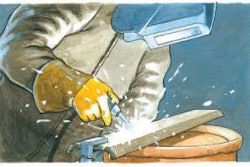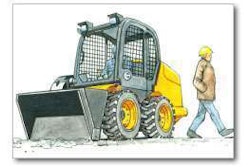Where Small is Big
Looking for a compact excavator? There’s no shortage of choices and options on the market
By Mike Anderson
For equipment considered foreign to North American contractors not much more than a generation ago, the compact excavator has become a mainstream part of their fleets.
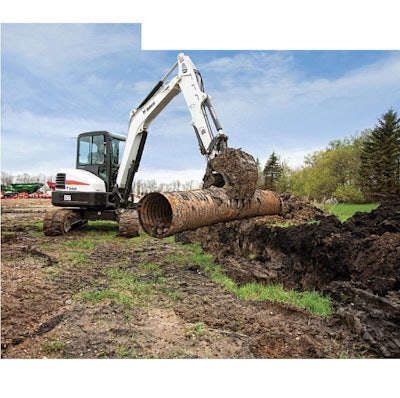 A new conventional excavator model from Bobcat, the Tier 4 Interim-compliant E55 has an in-track swing frame that keeps swing castings and cylinders within the width of the tracks when working the boom in an offset position. Drive motor covers are inset within motor wrap-arounds to protect them from damage.
A new conventional excavator model from Bobcat, the Tier 4 Interim-compliant E55 has an in-track swing frame that keeps swing castings and cylinders within the width of the tracks when working the boom in an offset position. Drive motor covers are inset within motor wrap-arounds to protect them from damage.Within the 3.0- to 6.0-metric-ton range alone, the 2011-2012 Equipment World Spec Guide lists 23 brands offering in excess of 85 base models – in conventional, minimal-tail-swing and zero-tail-swing configurations (see Machine Matters Roundup on starting on page 20).
The suppliers that introduced the compact excavator to the market are still here, and mainline manufacturers have joined them, all producing the compact machines, classified as up to 6 metric tons or 13,228 pounds in operating weight.
“Compact excavators are quickly taking on many of the jobs formerly done by larger backhoes and excavators,” says Curtis Goettel, marketing manager, Case Construction Equipment. “By replacing these with a mini and a skid steer, you can be more efficient by completing two jobs at the same time and even in two locations for roughly the same financial investment.” Case expanded its compact excavator offering in 2011 with the introduction of the minimum-tail-swing CX55B which, at 12,295 pounds, represents a new class segment for the company. Fellow CNH brands Kobelco and New Holland did likewise with the 55SRx and E55Bx models.
A pioneer to the market, Kubota continues to offer a wide range of compact excavators – six base models in the 3.0- to 6.0-metric-ton range, split between conventional and reduced-tail-swing models. “Kubota’s excavators rely on combined maneuverability, power and reliability,” says product manager Keith Rohrbacker, pointing to the newest 5.0-ton-class conventional KX057-4 and tight-tail-swing U55 models, equipped with two auxiliary hydraulic ports. “This system has low flow plumbed to the right-hand joystick to operate the thumb. The left joystick controls a higher-flow circuit for attachments like hydraulic breakers,” he explains. “With this system, the thumb stays connected to one port, saving time when changing other attachments that require hydraulic power. The controls are standardized on both joysticks, so operation is really easy to pick up.”
 A new size class entry for Case, the 12,295-pound CX55B “is a compact excavator with all the power of a full-sized excavator,” says Curtis Goettel, marketing manager. The minimum-tail-swing excavator has Case’s B Series center-swing boom that enables the operator to dig around stationary objects or along obstacles.
A new size class entry for Case, the 12,295-pound CX55B “is a compact excavator with all the power of a full-sized excavator,” says Curtis Goettel, marketing manager. The minimum-tail-swing excavator has Case’s B Series center-swing boom that enables the operator to dig around stationary objects or along obstacles.And therein lies a catalyst for the market growth. Highly versatile, maneuverable, compact digging machines can, when equipped with the correct attachment, be equally as productive in other applications. “The mini’s tracks also allow it to operate with minimal ground disturbance and maximum stability. Its compact size and articulating boom allow it to get into areas larger machines cannot,” says Goettel. “This is not only important around structures and houses, but also in demolition applications under a bridge or inside a building. Their relatively light weight allows minis to be craned onto bridges and buildings during demo.”
STILL ‘COMPACT’?
So when exactly does an excavator stop being compact? You’ll find a variety of definitions among manufacturers.
 By matching the engine and hydraulic systems, modern compact excavators such as Kobelco’s 35SR ACERA offer a balance of power for heavy digging and smooth control for fine grading, suiting them for utility applications.
By matching the engine and hydraulic systems, modern compact excavators such as Kobelco’s 35SR ACERA offer a balance of power for heavy digging and smooth control for fine grading, suiting them for utility applications.While the 5.0- to 6.0-metric-ton size class as identified by the Association of Equipment Manufacturers (AEM) is considered the upper limit of the compact range, meaning a cap of 13,228 pounds, a number of manufacturers market their “midi” excavators – even those beyond 20,000 pounds – as members of their compact families.
Compact equipment manufacturer Yanmar doesn’t stop at its 11,532-pound ViO55-5 excavator, offering the 18,000-pound-plus ViO80. “I don’t think most purchasers worry about the differentiation between mini, midi and compact,” says Bill Gearhart, product marketing manager, Yanmar Equipment Division. “Excavator users usually buy based upon digging depth, reach, lift capacity and productivity.” There is no official designation of mini or midi, says Gearhart, who believes all excavator models up to 12 metric tons to be compact, regardless of the AEM weight range they fall into “Weight category would usually give a purchaser a basic idea” of the performance specs primarily desired by the equipment users.
Moving beyond its sub-6.0-metric-ton model range topped by the TC60, Terex classifies the 16,538-pound TC75 as a midi excavator. “Because of the difference in horsepower and hydraulic output between the TC60 and the TC75,” says Jamie Wright, product manager, Terex Construction, “when a customer is working in larger, less confined areas where performance is based on time and amount of material dug and moved, they will most likely be better off choosing the larger excavator with a greater capacity.”
As with its sister Hitachi ZX60USB-3 model, the John Deere 60D surpasses 13,230 pounds, but there is a clear distinction between it and the next machine up, says the company. “The 75D might be considered a midi, but at John Deere it’s the smallest of our midsize excavators,” says Mark Wall, product marketing manager, excavators. This machine has features more in common with the midsize class (identified by Deere as up to 50 metric tons), while the 60D has more features in common with the compact excavators.”
It’s a similar sentiment for JCB customers, who view the 14,515-pound 8065 as a compact excavator, “because it’s still far smaller than our full-size models,” the company says.
“Once you get out of the ‘true’ minis, you also get out of the landscape, independent rental and residential construction segments,” says Goettel, noting those three areas alone made up 64 percent of total industry volume according to AEM 2009 and 2010 data. “The main midi customers do highway, road and bridge, and larger non-residential work. These are areas where minis are used, but not where the bulk of minis are sold.
The swinging boom on a midi makes it closer to a mini, says Goettel, but the size and expense can take it out of the compact market. Another defining point, he says, is transportability. “Minis are designed with trailer transport in mind. Even the larger minis can be towed on most roads without special licenses or permits. Midis often require larger trailers or trucks to transport,” says Goettel. “There are a couple manufacturers marketing 6- to 7-ton machines as minis, and market demand might develop for 5.5- to 6.5-ton machines, but by then you are really getting into true midi applications and transport issues.”
The hauling issue is key to mindset, concurs Rohrbacker. “Contractors are already using a towing rig that requires a Commercial Driver’s License when they move a 6-ton machine around. An 8-ton machine can often be towed on the same rig, which may contribute to the feeling that it is a compact excavator,” he says.
Rohrbacker tries to stand back for a big-picture perspective of the definition debate. “I look at the combination of compact and hydraulic (full-size) excavators as the stones lining an archway,” he says. “Imagine compact excavators starting on the left side, smallest excavators at the foundation and the size increasing as we move up the arch. On the other side of the arch are hydraulic excavators, with the smallest starting at the top of the arch and the larger sizes heading down toward the foundation.
“Consider that for compact excavator manufacturers the 8-ton may be the largest they make, and for hydraulic excavator manufacturers it is one of the smallest excavators they make. That places the 8-ton excavator as the key stone, in the center at the top.” EW
ROUNDUP
John Deere
 50D
50DAt 7,760 and 10,811 pounds, the John Deere 35D and 50D excavators leverage zero-tail-swing design with 360-degree rotation and independent-swing booms for production in close quarters. A standard coupler accommodates a variety of attachments, including hydraulic breakers and augers, powered by standard auxiliary hydraulics. Options on arm length, track length, angle blades and operator stations allow these compact machines to be outfitted for various production requirements. Considered a compact excavator by John Deere, the reduced-tail-swing 60D weighs 13,653 pounds or 6.19 metric tons – slightly beyond the industry’s official maximum weight for this classification – but has more features in common with the smaller models than the midsize Deere lineup starting with the 75D.
For product info, visit: deere.com/wps/dcom/en_US/products/equipment/excavators/excavators.page
Hitachi
 ZX50U-3
ZX50U-3Reinforced D-shaped frames like those on Hitachi’s larger Zaxis excavators provide the zero-tail-swing ZX35U-3 and ZX50U-3 compact excavators with lower centers of gravity and increased stability, enhanced by weighted undercarriages. A single large swing pin increases the stiffness of the boom and arm, eliminating jerky movements, the company says. Using the same hydraulics system as Hitachi’s full-sized models, the 7,760- and 10,811-pound compacts are suited for delicate digging around utilities, as well as more punishing applications with hammers and other attachments. The reduced-tail-swing ZX60USB-3, considered a compact by Hitachi, weighs 13,653 pounds and thus slightly beyond the 6.0-metric-ton mark.
For product info, visit: hitachiconstruction.com/products-and-equipment.html
Terex
 TC48
TC48Available in five model sizes in the 3.0- to 6.0-metric-ton range alone, the Terex compact excavator design balances machine production with component protection. Positioned out of the way of potential damage, top-mounted boom cylinders are also inverse-mounted so their seals face down, preventing dirt build-up. Cushioned cylinders are end-position-dampened to extend service life while minimizing inertia forces and reducing cylinder shock. With their articulating boom cylinders, the Terex TC35/35E, TC37, TC48, TC50 and TC60 excavators operate flush against obstacles. Compared to linkages that extend further than the tracks – which Terex says are susceptible to damage and offset zero-tail-swing advantages – the linkage on Terex machines is flush with the tracks to protect vital components.
For product info, visit: terexconstruction.com/en/products/new-equipment/excavators/compact-crawler-excavators/index.htm
Yanmar
 ViO35-5
ViO35-5Having invented the zero-tail-swing configuration, Yanmar says it has enhanced lift capacity and machine stability in each of four successive ViO machine generations. Rated at a ground distance of 8 feet 2 inches with their front blades down, today’s standard 7,850-pound ViO35-5, 10,245-pound ViO45-5 and 11,532-pound ViO55-5 excavators lift 4,006, 4,494 and 5,585 pounds, respectively. The offset VICTAS – ViO Crawler Technology for Advanced Stability – tracks further enhance lifting and digging capacity over the side, says Yanmar. The ViO55-5 is available with an angle blade; all models come with factory-installed hydraulic quick couplers. When equipped with a cab as compared to a canopy, the smaller ViO27-5 model is just above the 3.0-metric-ton level, weighing 6,750 pounds.
For product info, visit: http://www.us.yanmar.com/products/construction/excavators/vio/
Wacker Neuson
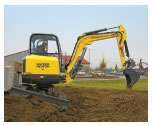 38z3 VDS
38z3 VDSThe newest addition to the well-populated Wacker Neuson compact excavator line is not another machine, but rather the Vertical Digging System initially available on three zero-tail-swing models, including the 8,488-pound 38z3 and 11,354-pound 50z3. With the push of a button, the operator tilts the cab and boom up to 15 degrees to compensate for slopes up to 27 percent. Even with uneven terrain below the machine, the operator remains in an upright position when working, resulting in “optimized” swiveling and dumping height. This, says Wacker Neuson, translates into time and material savings up to 25 percent when excavating and backfilling. In this range, Wacker Neuson also offers the conventional 8,219-pound 3503 and 12,842-pound 6003 models, likewise with heavier frames and arms.
For product info, visit: wackerneuson.com
Hyundai
 R60CR-9
R60CR-9As part of a new generation of Robex compact excavators, Hyundai offers the 8,050-pound R35Z-9, 12,460-pound R55-9 and 12,790-pound R60CR-9 models, providing a choice of configurations to suit particular jobsite needs. The latter provides a brand new compact-radius option in the 5.0- to 6.0-metric-ton range, alternatively served by the conventional R55-9 with its additional 9 inches of dig depth, up to 12 feet 6 inches. Side overhang on the heavier R60CR-9 is reduced from 27 to 7 inches. An advanced hydraulic system provides operators precise control of all models including the zero-tail-swing R35Z-9, says Shane Sirmons, sales and product support manager. Improved hydraulic valves and variable-volume piston pumps give flow regeneration that optimizes machine performance, he explains.
For product info, visit: hceamericas.com/WCC/WCC0010.aspx
Kobelco
 55SRx ACERA
55SRx ACERARepresenting a new model size in the ACERA compact excavator line, the 12,295-pound 55SRx boasts increased counterweight and rear swing radius compared to Kobelco’s smaller zero-tail-swing models, for added stability when using larger buckets and lifting heavier loads. As well as high-performance hydraulics, the new short-radius excavator uses structural components found on full-sized Kobelco excavators, including a large cab, cast center swing foot, and heavy-duty reinforced boom and arm. The 55SRx comes with a factory-installed attachment bracket – making it thumb-ready – and has piping for secondary hydraulics if needed. A two-way backfill dozer blade with a 38-degree approach angle is standard; a four-way blade is optional. Also available in this size range are the 35SR and 50SR models.
For product info, visit: kobelcoamerica.com/products/compacts/Pages/compacts.aspx
Case
 CX55B
CX55BIn the last year, Case expanded its compact excavator product line into the 5.0- to 6.0-metric-ton class with a new 12,295-pound minimum-tail-swing model. “The CX55B is a compact excavator with all the power of a full-sized excavator,” says Curtis Goettel, marketing manager. An easily transportable machine with a height of only 8 feet 4 inches it is able to deliver 12 feet 10 inches of dig depth and 11,240 pounds of bucket digging force. The CX55B comes thumb-ready with factory-installed hydraulics and an attachment bracket; also available is piping for secondary hydraulics. The newest Case compact excavator has a full cab design – 7 inches wider and 10-percent larger than that of the 6,679-pound CX31B, 7,958-pound CX36B and 10,261-pound CX50B models. The fuel tank is 40-percent larger. For product info, visit: casece.com/wps/portal/casece/product?product=ExcavatorsCMP&brandsite_brand=CaseCE&brandsite_language=en&brandsite_geo=NA
Takeuchi
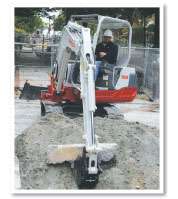 TB235
TB235Some manufacturers may label them zero- or minimal-tail-swing excavators, but Takeuchi identifies its reduced-swing models by FR – as in Full Rotation. Within the 3.0- to 6.0-metric-ton range, the TB138FR and TB153FR are able to complete a full upper-body revolution with minimal rear and front overhang – the front overhang being the key to what sets this product family apart, Takeuchi says. The side-to-side STS boom system allows for offset digging while retaining machine stability and operator visibility. All Takeuchi excavators in the size range, including the conventional TB235 and TB250 models, are equipped with the pilot accumulator boom-lowering device and proportional auxiliary controls. High-flow hydraulics, load safety device and lift alarm are standard on the largest TB250 and TB153FR models.
For product info, visit: takeuchi-us.com/www/docs/1/compact-excavating-products
JCB
 8035Z
8035ZDouble-acting pipework, standard on all JCB excavator models in the 3.0- to 6.0-metric-ton range, facilitates use of higher-flow hydraulic attachments such as the company’s own Hammermaster demolition breaker. This is especially useful when quick-release couplers are equipped to the heavy-duty-frame models – the zero-tail-swing 8030Z at 7,092 pounds, 8035Z at 8,049 pounds, 8040Z at 9,480 pounds and 8045Z at 10,472 pounds, as well as the reduced-tail-swing 8055 at 11,660 pounds. Large front, side and top glass in the cabs, along with narrow booms and dippers, provide operators with enhanced visibility to the work area, says JCB. Auto-kickdown tracking automatically changes the driveline gear to suit the site conditions; a dozer blade rolls material away instead of allowing build-up.
For product info, visit: jcbamericas.com/products/2-construction/4-mini-excavators/
Komatsu
 PC45MR-3
PC45MR-3Komatsu combines a minimum-tail-swing, low-ground-pressure package with “big machine” features such as an X-frame undercarriage and castings in key areas. The Komtrax wireless machine monitoring system – today a staple of the full Komatsu construction product line – is likewise standard on the compact excavators including the 7,909-pound PC35MR-3, 10,573-pound PC45MR-3 and 11,378-pound PC55MR-3. Proportional Pressure Control (PPC) joysticks provide “continuous, comfortable operation,” says Komatsu. An optional hand control for the auxiliary circuit gives operators a choice of hand or foot controls when using hydraulic tools such as hammers. Also available as an option, the power angle blade shifts 25 degrees to the right or left for efficient backfilling.
For product info, visit: komatsuamerica.com/excavators
Kubota
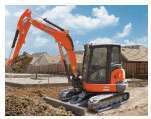 U55
U55Kubota offers conventional (KX91-3, KX121-3, KX057-4) and tight-tail-swing (U35, U45, U55) models that continue to leverage advanced hydraulic systems combining flow-controlling piston pumps with pressure-compensating main control valves. The speed of each hydraulic circuit is controlled by lever stroke; increased lever stroke is not required to maintain operating speed, ensuring efficient operation, the company says. When lifting a street plate or placing landscaping material, the machine’s attachment starts moving as soon as the lever is stroked, eliminating dead spots or wait time. Wasted energy is reduced because excess oil returning to the tank is eliminated.
For product info, visit: kubota.com/product/KXSeries.aspx and kubota.com/product/USeries.aspx
Bobcat
 E32
E32Bobcat has now turned over its complete 3.0- to 6.0-metric-ton excavator range to the M-Series, noted by the “E” nomenclature. Newest among six models ranging from E32 to E55 is the largest, a 12,478-pound minimal-tail-swing unit introduced last year. The E55’s 13.4 inches of tail overhang boosts lift capacity and slew performance in the most demanding applications, says Bobcat. When activated by the operator, auto-idle will automatically take down the engine if excavator functions are not used for four seconds, saving fuel and cutting noise. A new extendable arm option for the conventional E32 and zero-tail-swing E35 provides 30 more inches of reach while retaining use of the hydraulic clamp and attachment mounting system.
For product info, visit: bobcat.com/excavators/models/overview
IHI
 55VX-3
55VX-3Four zero-tail-swing VX models recently updated to Dash 3 status join with two conventional N machines to form an extensive IHI 3.0- to 6.0-metric-ton excavator range that offers maximum dig depths from 10 feet 6 inches to 12 feet 8 inches. A newly redesigned operator’s “space” on the 30VX-3, 35VX-3, 40VX-3 and 55VX-3 models, as well as on the 35N-3 and 55N-3, features hand-fitted joystick controls, auxiliary hydraulics selection and continuous flow buttons and – compared to a pedal – a two-speed travel button located on the backfill blade lever. The blade itself has been strengthened by extending the lower lip and boxing the upper portion. Segmented blade and boom cylinder hoses make replacement easier, the company says. Also, the work light on the boom has been moved to prevent breakage.
For product info, visit: ihicompactexcavator.com/mini-excavators/
Volvo
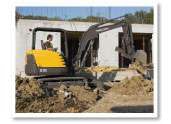 EC35C
EC35CIn the words of Volvo compact product competency manager John Comrie, “there is no point to having a high breakout force and low tear-out force.” To that end, Volvo’s three short-radius and two conventional excavators in the 3.0- to 6.0-metric-ton range match the two forces to allow easy filling of the bucket, says Comrie. Each powered by Volvo engines turning out 27.6 to 50.8 net horsepower, the compact-radius ECR38, ECR48C and ECR58 excavators range in maximum dig depth from 9 feet to 11 feet 10 inches. At 34.9 and 47.1 horsepower, the conventional EC35C and EC55C offer a dig depth up to 11 feet 3 inches and 12 feet 4 inches. Volvo features such as engine return-to-idle and automatic travel downshift allow inexperienced operators to concentrate on primary production tasks, says Comrie.
For product info, visit: volvoce.com/constructionequipment/na/en-us/products/excavators/compactexcavators/Pages/introduction.aspx
New Holland
 E50B
E50BExpanding its compact excavator line to a new size class, New Holland introduced the 12,295-pound E55Bx at CONEXPO-CON/AGG 2011. While retaining a modest cab height of 8 feet 4 inches for easy transport, the new 39-horsepower model’s dig depth of 12 feet 10 inches suits it to a wide range of residential, underground, landscaping, demolition and commercial projects, the company says. The E55Bx, with the robust design features of a full-sized excavator, has a lower structure extending to the sprockets to reinforce the undercarriage. Rubber and steel tracks are available. As on the E35B and E50B models, a three-pump “smart” system allows simultaneous operation of the swing and boom/arm functions while operating the dozer blade, without affecting travel speed or direction.
For product info, visit: northamerica.construction.newholland.com/family.php
Caterpillar
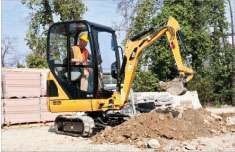 304D CR
304D CRWhen Caterpillar introduced the D Series compact excavators, the 3.0- to 6.0-metric-ton range took a collective shift up in size and nomenclature. With model designations reflecting operating weight in metric tons, the 303.5D CR, 304D CR, 305D CR and 305.5D CR models replaced the 303C CR, 303.5C CR, 304C CR and 305C CR respectively. Increased-width undercarriages for the two smaller zero-tail-swing models and heavier counterweights for the two larger compact-radius machines enhance stability for increased productivity, says Caterpillar. A new pin-grabber-type coupler – with hydraulic operation available as an option – combines positive work-tool retention with a design that maintains tight tolerance between the coupler and attachment. A two-mode auxiliary hydraulic system is standard.
For product info, visit: cat.com/equipment/hydraulic-excavators/mini-hydraulic-exavators




